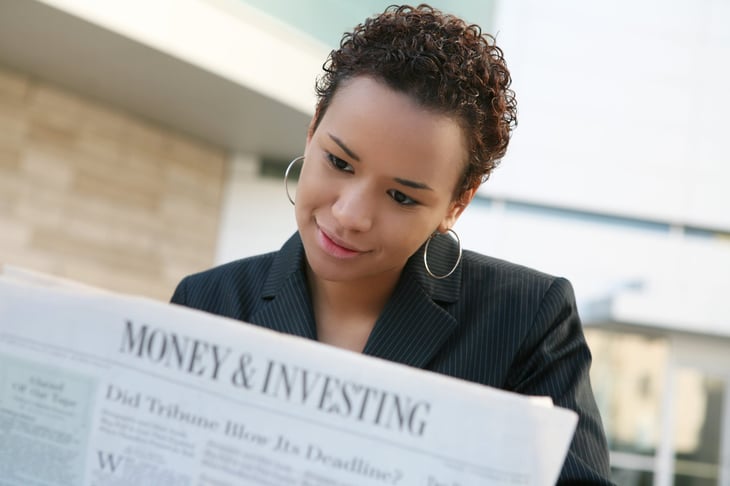
Editor’s Note: This story comes from Wealthramp.
Active investing and passive investing are two contrasting approaches to making your money work for you in today’s market.
Both philosophies use the S&P 500 as a benchmark to gauge the success of their performance, however active investing will typically aim to outperform the benchmark, while passive investing will strive to replicate it.
Now you’re probably wondering which strategy is best for you? Well, the answer is not that simple.
I got into the business of active investing over 30+ years ago. I quickly climbed the ranks and became a Certified Financial Planner (CFP®) and then moved on to getting certified as a Chartered Financial Analyst (CFA) and Chartered Market Technician (CMT).
Generally speaking, CFAs are taught how to avoid risks, while CMTs learn how to make money. A successful active investor or active investment manager will focus on and excel in both of these areas.
Throughout this article I’ll break down both strategies, the advantages and disadvantages to each side, how I typically advise my clients and talk about a story or two in which an active investing strategy was successful for my clients.
What’s the Difference?

First in order to understand whether an active or passive investing strategy is right for you, it’s important to understand what each means.
Let’s start with passive investing. Passive investing is mostly “buy and hold.” It is “set it and forget it,” create the portfolio and then walk away.
A lot of people will do that with individual stocks. They may do that with mutual funds or with index funds, but at its heart passive investing is setting up a portfolio and letting it run for a while.
On the other hand, active investing involves investment managers who are actively involved in managing their portfolios. They are periodically buying and selling to take advantage of opportunities and to avoid risks.
How Does It Work?

The overall goal of active investing depends on the investor. When you are running active portfolios, you can either manage it for additional growth or you can manage it to avoid risk.
Diving deeper you can also do other things such as attempt to manage the portfolio to become more tax efficient or perhaps even more socially responsible.
In general, there is a lot more freedom with customization and optimization when managing actively over managing passively.
Now if you’re working with an adviser then he/she probably has a process they’ve taken you through, sort of a discovery call to get all parties on the same page. Usually when I talk to clients they almost always want to see their portfolios grow.
In addition, they want to have income, and to have absolute stability. In a perfect world, that’s all fine and dandy.
But to be realistic, you can have one or two of those things, but you can’t have all three happening at once.
What Every Investor Should Know

The first thing I like to do when I meet with a new client is talk about their current investments.
I want to gain a sense to see if they feel that those investments are still appropriate, still accomplishing the job that the client had intended them to do.
Afterwards, I’ll put together a report card on how those investments are performing, and then together we’ll go through each investment and together devise a game plan to figure out which investing strategy is best suited for them and then what the next steps should be.
Benefits of Active Investing

Now that I’ve sort of laid out the general premise of each investing strategy and some of the overall goals, let’s dive into some of the advantages and disadvantages of active investing.
Customize Your Portfolio

One of the biggest advantages of active investing as I mentioned before is that you can apply more customization. You can do some tax optimization, you can also make adjustments for ESG factors.
That’s the type of activist investing for environmental, social, or governance purposes. The world is your oyster.
Actively Manage Risk

The second biggest advantage I see is that you are actively involved in the process of managing risks, which to some degree means you can avoid catastrophic blow-ups because you can catch them sooner rather than later in the process.
The conversational value of having a portfolio that changes with the times I personally think is better than having the same stock that you inherited 20 to 25 years ago.
The Potential to Outperform the Market

Finally, perhaps the most tantalizing advantage to active investing is that if you are an active investor, you have the opportunity of outperforming the market.
Now it doesn’t always happen and we’ll talk more about that later, but if you do the same thing that everyone else is doing, it’s probably going to yield you the same results.
On the flip side to that coin, if you do something that’s a little bit better, a little bit different, maybe you can get incrementally better results.
Drawbacks of Active Investing

Now active investing isn’t always sunshine and rainbows; there are a few disadvantages to this investing philosophy. For starters, it can be very difficult to beat the market.
Even if you read all the books and online articles or hire the most world-renowned adviser, active investing is never a sure thing, you are bound to see times when you lag the market.
The other drawback you can experience is that when working with investment managers who are active — it is common that you’ll end up paying that manager more than you would a passive manager.
The cost will be a little bit higher than managing an index fund, but you would hope that there would be other ways of adding value, again, either by adding incremental returns or by managing risk.
Remember to Check the Fees

There are a few different levels of fees that you need to look at, the first is the fee of the investment vehicles. Will you use an exchange traded fund or an index fund?
Typically, those fees are gonna be very minimal. They can run anywhere between 0.1% to 0.5% per year.
If you are doing passive investing through a mutual fund that is actively managed, you can pay typically anywhere between 0.25% to 2% on that mutual fund.
If you are working with a manager to manage those funds for you, he or she may have a charge on top of that as well.
Now some active managers are able to manage portfolios of individual stocks, and in that case, you can have a conversation with that manager who might not charge more than you would typically pay with a mutual fund.
Performance of Actively Managed Portfolios

When it comes to my practice, I’m constantly looking at my performance each and every day. I typically send out monthly reports to my clients that illustrate the performance of the strategies we devised together and how well they compared to the benchmark indexes we choose to use.
However, when you look at the research, it shows that 80% to 85% of active managers have not been able to outperform their index benchmarks.
Furthermore the degree of underperformance tends to be roughly equal to the fees that they charge. An index represents an average investment. About half the people will be able to outperform the index, and half the people will underperform the index.
When it comes to active managers, they tend to underperform to the extent that they charge fees on accounts.
Timing and Strategy Matter

There are a few other ways of looking at this as well; passive investors tend to invest through their 401(k) plans.
Those 401(k) plans tend to buy index funds, and they tend to buy those index funds all at the same time every month, either at the beginning of the month or in the middle of the month when you get paid.
I have built a timing strategy that anticipates this flow of money going into index funds among other factors. If you want to be in the right place at the right time, it’s helpful to show up a little bit early, which is what I do.
I show up a day or two early, and I have been able to generate fairly consistent returns for my clients by timing the market based on this “sugar rush” that comes at the beginning of each month, around holidays and over the winter.
Client Success Story No. 1

One of the greatest benefits of working with an adviser when it comes to active investing is to get insight on timing. Timing is everything when it comes to the market, and can be the sole reason as to whether you come out on top or lose a good portion of your money.
In a bear market it’s even more important. My main focus right now is cautioning my clients to be a little more hesitant on executing trades without doing a full discovery and due diligence on whether the time is right to make these moves.
So I had a client who had a portfolio of about $400,000 that she wanted to get with me right away. We opened up some accounts for her, and then we held cash for the first month.
We intentionally did absolutely nothing with it. And in doing so, we managed to avoid about $40,000 in losses because the market went down by about 10%.
Client Success Story No. 2

I had another client come in the same month who had a lot of cash on the sidelines and was curious if they should be putting it to work.
The client had a few stocks that he wanted to invest in and after reviewing his suggestions, I agreed; they looked like solid companies and good investments, however I didn’t quite think the timing was right.
Instead of just going in at the market and buying the stocks immediately, I suggested we put in a low-ball buy order. If you didn’t know, you can do something called a limit order, where you can specify the price that you’re willing to pay for a stock over the course of the next 60 days.
We placed a low-ball limit order to buy some stocks, and it worked out tremendously well. We were able to end up saving him $90,000 on the implementation of those trades. Those savings more than paid for my advisory fees for the first year!
Is Active Investing for You?

First you need to ask yourself if you want to be actively engaged in watching over your portfolio.
If the answer is yes then you need to figure out what type of investor you want to be. For aggressive clients sometimes it’s hard to invest aggressively if you’re in a mutual fund or an index fund.
You don’t want your portfolio to consist of too many technology stocks or have too much crypto exposure because that can be very risky.
Sometimes I work with clients to develop portfolios that can generate high dividend yields for them.
When Passive Investing May Be a Better Fit

If you don’t really care about where you’re investing or tracking the performance on a more frequent basis, then I would not recommend active investing on your own or even with an active manager.
If you’re just happy to lock it up and put it into an index fund and not look at it for five or 10 years and don’t want any involvement at any level whatsoever, then passive investing may be the way to go for you.
